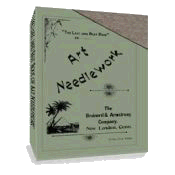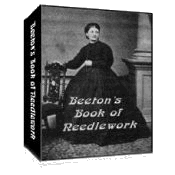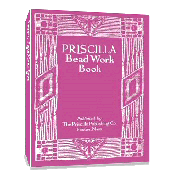Victorian Knitting Stitches
Victorian ladies could find instructions for various knitting stitches in a great number of books that were published at the time. Below you will find information as published in 1895 for ladies to follow.
Various Knitting Stitches.
Purling or seaming is in reality knitting backwards, as the stitch is taken up in a contrary direction from plain knitting. Before beginning to purl, the thread must be brought in front of the needle, and if a plain stitch follows, the thread is passed back after the purl stitch is made.
Increasing, or making a stitch, is done by throwing the thread once round the needle, and in the next row knitting it as an ordinary stitch.
Decreasing is done in two ways: Firstly, taking up two stitches and knitting them together as one; secondly, by taking up a stitch without knitting it, called slipping, then by knitting the following stitch in the usual way, and then slipping the first (unknitted) over the second (knitted). When it is necessary to decrease two stitches at once, proceed thus: Slip one, knit two stitches together, then slip the unknitted stitch over the two knitted together.
Casting off stitches, the operation by which a piece of knitting is finished, is done by knitting two stitches, and with the left-hand needle slipping the first, knitted over the second. This is continued to the end of the row. In finishing off a piece of work, the casting off must be done very loosely, otherwise it will be much tighter than the other rows of knitting.
Ribbed-Stitch is made by knitting and purling alternate groups of stitches. There may be one stitch or more in each group.
Chain-Stitch was much used for the knitted quilts, so much affected by knitters and housekeepers of an earlier period. For the couvre-pieds, or sofa blankets, now in vogue, it will be found most effective, especially if each successive row be knitted in carefully harmonized or contrasted colors, It requires three needles.
The mode of knitting is as follows: Set on thirteen stitches, knit two plain rows. * knit three stitches, purl seven, knit the last three. Knit the next row plain. Repeat from * until sixteen rows have been knitted from * inclusive. Now knit three stitches plain, take off the next four upon the third needle; knit the next three from behind the third needle so as to entirely miss it, drawing the wool very tight, so as to connect the two needles closely together. Then knit the four stitches of the third needle, completing the twist. Knit the remaining three and begin to form a fresh pattern by knitting three stitches, purling seven, knitting three, as before for sixteen rows. Then twist again as above.
Open Hem is one of the old stitches and is suitable for fine needles and silk. Set on any number of stitches that is divisible by four. Slip the first stitch of each row, knit the second, put the silk over the needle to make a stitch, knit two together, repeat from star to the end of the row. All the rows are knitted exactly the same as this one, but the whole pattern depends on the number of stitches being divisible by four. The pattern is very simple and very pretty, forming a kind of herring-bone stitch in alternate rows and solid knitting.
Double-Knitting is equally simple, and is very useful for socks, shawls, and the cuffs of warm winter mittens. The stitches for double knitting must be even in number. Knit a stitch T. T. O. once, slip a stitch off without knitting it, knit a stitch T. T. 0, once, and so on through the whole of the row. The reason for having an even number of stitches is that the stitch that is knitted in one row must be slipped in the next.
Honeycomb-Stitch, so called because it forms a series of hexagons, is done as follows: Knit the first stitch, put the silk over the needle to make a loop, knit two stitches together. Continue making a loop and knitting two stitches together till the row is completed. Then knit a row of plain knitting, another row of honeycomb-stitch, and then one of plain knitting, Mittens knitted with this stitch in fine purse silk look very well.
French-Stitch makes a pretty kind of fancy rib; It also very simple. Cast on the stitches in four, leaving two over. These two (one at each side of the row) form a strong- edge, resembling chain-stitch in crochet. Purl the first stitch, put the thread back, * knit two stitches together, make a stitch by putting the thread over the needle, knit a stitch, T.T.O., once, purl a stitch, repeat from *. At the end of each row, put the thread back and knit the last stitch.
Crow's-foot-Stitch, is very effective, forming a series of thick stitches alternately with a series of open-work. Set up any number of stitches divisible by three, with one over After having knitted one plain row, begin the pattern as follows: Knit the first stitch, * make a stitch, slip a stitch, knit two plain stitches, pass the slipped stitch over the two plain ones, repeat from *. Purl the whole of the next row.
These knitting stitches were the more commonly used stitches at the time and are still used today. Try your hand at using some of the above knitting stitches by using an AUTHENTIC VICTORIAN KNITTING PATTERN for Lady's Fancy Mittens.
To learn how to read a Victorian knitting pattern and use the above knitting stitches, see Abbreviations and explanation of terms to be found in rules for knitting.
Return to Top of Knitting Stitches page.
Return to Knitting page
Return Home from Knitting Stitches page.



 433 pages!
433 pages!

